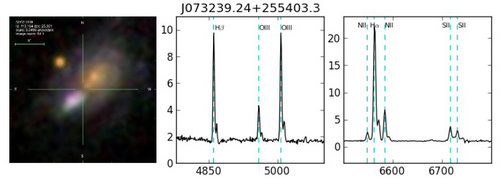Double-Peaked Profiles Recognition and Evaluation Frame Based on LAMOST Spectroscopy
Recently, Caixia Qu, Haifeng Yang, Jianghui Cai and others from Taiyuan University of Science and Technology have carried out a research on the method of double-peaked profile recognition and evaluation using LAMOST spectral data, and proposed a set of technical frameworks for rare feature extraction, feature characterization, feature recognition and quality evaluation. This new technical framework can provide reliable support for efficient searching and identification of double-peaked emission line spectra, and is also a good reference for the mining of other particular celestial objects. This work has been published this April in IEEE Access.
Double-peaked emission lines in spectra are always connected with the interactions of galaxy pairs, the jets of active galactic nuclei, and double black holes, so they play an important role in the study of these objects and phenomena. At present, such spectrum samples that have been confirmed are very rare. LAMOST has released more than 200,000 spectral data of extragalactic galaxies, which provides valuable data support for searching and discovering such celestial objects.
However, the real spectra obtained from observations are always not so ideal as expected. The double-peaked profiles have different shapes, different strengths, and different conditions affected by noise, and even different lines in the same spectrum can present differently. These complex and diverse features significantly increase the difficulty of searching the spectra with double-peaked emission line profiles from huge dataset. So currently the searching and selection work still relies on human eye inspection, which is burdensome and time-consuming.
By analyzing the characteristics of the double-peaked emission line profiles in LAMOST spectra, the researchers designed the recognition and evaluation frame for double-peaked emission line profiles (SVM-LATTICE), where advanced data mining and machine learning techniques were introduced. This technical framework can achieve more than 50% automatic recognition of double-peaked profiles on the premise of ensuring completeness, which greatly reduces the work of human eye inspection. Meanwhile, it is also faster than traditional template matching methods in automatic searching. The produced results can also provide a statistical basis for physical analysis.

Figure: Examples of double-peaked emission lines in spectra (middle and right), and the corresponding photometric image is also shown (left).
Link to the paper:https://ieeexplore.ieee.org/document/9079538.